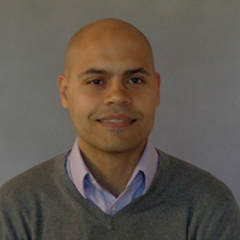
Randall Brown is an economist working out of our Cambridge, Massachusetts office, who has been with Mathematica for more than 40 years. As a director of the Health Policy Assessment Division, he’s been instrumental in building our expertise in health care evaluation and study design. James Haven is a health care researcher who joined the Princeton office last October and is focused on health care quality improvement. In celebration of Mathematica’s 50th anniversary, we brought the two together for a virtual conversation about what’s changed—and what hasn’t—at Mathematica.
Randy Brown: How long have you been here, James?
James Haven: Seven months—to the day, actually. How about you?
RB: I started right after grad school in 1977. It was the perfect job for me.
JH: This was the perfect job for me, too.
RB: I couldn’t believe I found a job where I could use all the cool statistical techniques I’d learned in school and at the same time contribute to solving problems that were front page news. I even got to work with Mark Pauly and Uwe Reinhardt—two of the most well-known and oft-quoted academic health researchers in the country—during my first year here! Of course, it wasn’t all perfect. On my first day at the old Mathematica building, my choice was to share an office or work in the library. I was in the library for quite a while.
JH: One of the things I noticed on my first day was how nice the office space is in Princeton. And the people, too. A number of folks invited me to lunch. It was awesome—I had lunch plans on day one.
RB: That’s always been true about us. When we were a smaller group starting to expand, we turned away some pretty good job candidates because we thought, “well, would you want to work with that person?”
JH: [laughs] Your hiring model worked. I can’t believe how many people have been here for 5, 10, or more than 20 years.
RB: We had to get along. We were in one small space—and sharing one big computer. Mathematica’s first computer was a whopping IBM machine, kept nice and cold, of course. If you had a large data set, it might have had to run all night.
JH: I can’t even imagine.
RB: Not only that—if you wanted to edit a report, you had to cut, paste, and tape corrections onto the page. We had reports with 18 layers of tape on them! We used a light table to make sure the lines were straight. We would collect the data, and five years later, the report was finished.
JH: That would be a hard sell today. We’re modeling new, faster options for clients all the time.
RB: In the early years of our company, we would use regression models to compare outcomes for our treatment group with those of a comparison group or a control group from a random assignment study. But in the last few years, we’ve changed our methodology quite a bit, mostly because of advancements in technology. You can’t do Bayesian analyses with one computer in the basement.
JH: I finished grad school in 2011. We studied some Bayesian. But it’s not really the traditional type of statistics you have in school today. I’m still learning.
RB: We all are—whether you’re here six months or 41 years. We used to only be able to tell a policymaker whether a policy was having an effect greater than zero. Now we have the computing power to run Bayesian analyses and say things like “there’s a 76 percent probability that the effect of the program is greater than the cost.” It’s a huge improvement.
JH: And then there’s the machine learning that comes into play in some of my projects, which adds even more value. But at the same time, these new models are pointing out gaps in our understanding. We can create a great predictive model that might show the health spending for a particular patient over the next six months, but we often don’t understand the real-world reasons or causes behind the prediction.
RB: Your work is very different than what we used to do here. When I started, it was all about evaluation: does this program work? Although we did site visits to figure out how the programs worked, the emphasis was on impact analysis. Can you solve this social problem with this new intervention? And although we still do that, we now do just as much work in the space of program improvement, which relies on the kind of data science you describe.
JH: I don’t know too much about evaluation work, but my understanding is that it’s about examining a single truth, or what we can call a truth about something, and testing a hypothesis over time. Whereas when data science is leading program improvement, the goal is often to present multiple options concurrently—and move quickly between them. If we’re trying something and it doesn’t work, we have to be ready to move on, model a new approach, and start it up fast.
RB: I think no matter what the project, if you clearly define the question, you’ll find the right approach. Get the right people into the room and right methods will follow. Luckily, we have this great company of people with deep experience and people with knowledge of new methods. That’s what makes Mathematica such a fun place to work. There were seven people who started with me more than 40 years ago, and five of them are still working here.
JH: Fingers crossed that’s me!
RB: Although I work from home now. The only disadvantage is that I miss bagel Friday.
JH: I love the Friday bagels!
RB: I’d say it’s a tradition worth keeping.
JH: I’ll put my name on the line for that.

Randall Brown (left) and James Haven (right) “meet” during their recent conversation about working at Mathematica.



